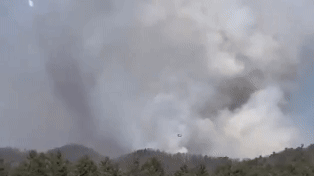'Table was set for fires': Western North Carolina burned by Helene aftermath

Six months ago, Hurricane Helene’s powerful winds and torrential rains caused “the most devastating natural disaster in western North Carolina’s history,’’ according to the National Oceanic and Atmospheric Administration.
Now the region is getting hit with a spate of wildfires that have prompted nearly 200 mandatory evacuation orders and the activation of more than 260 personnel to battle what’s known as the Black Cove Complex fires.
Is that beautiful part of the state suddenly cursed? Not likely, but the events are interconnected.
The late-September deluge brought by Helene, resulting in widespread flooding and landslides that killed many of the 106 people who died in the state, was followed by a severe drought during a warm winter and early spring, drying out vegetation.
Brett Anderson, a senior meteorologist and climate change expert at AccuWeather, said the hurricane also left behind lots of dead trees and fallen branches, debris that became kindling. In addition, he said, the chances of a damaging blaze have been enhanced by stronger winds than usual and a large number of insects surviving the mild winter and harming trees.
Conditions were primed for blazes
“You add all those factors together, it set us up for high fire risk in areas where you don’t usually think of big fires,’’ Anderson said. “You usually think about the West. But the table was certainly set for fires, at least for this particular year.’’
Anderson noted that springs have been getting warmer in the central and southern Appalachian regions over the last 30-plus years, making for an earlier start to the fire season as greenery dries out and whatever snow is on the ground melts quicker.
The same thing is taking place in the Northeast, where a lack of foliage cover early in the spring allows much of the ground’s moisture to evaporate in the extended sunlight. Last fall was the scene of another weather phenomenon, as an extreme drought set the conditions for the Jennings Creek Fire, which burned more than 5,300 acres across the New York and New Jersey border in November.
There’s not enough long-term data to make an accurate prediction of whether such an anomaly will be common in the future, said Anderson, but it appears that way.
“I would not be surprised,’’ he said. “It’s almost safe to say that, in the next 10, 20, 30 years or so, big fires in the Northeast may not be as rare as they used to be.’’
Contending with fires in Helene aftermath a 'nightmare'
If that’s the case, residents of the area can only hope they don’t endure the dual hardships of the folks in western North Carolina. In their efforts to contend with the three wildfires that ignited last week in rural Polk County, only one of which is contained, firefighters are finding major obstacles from Helene.
They include fallen trees and the need to rely on temporary gravel roads to reach remote locations in steep terrain because the hurricane destroyed the previous routes, Blue Ridge Public Radio reported.
“ These conditions that we're facing right now is not like we've seen in the past,” said Polk County Fire Marshal and Emergency Manager Bobby Arledge, according to BPR News. “All the trees and everything that we've had down from Helene has been a nightmare.’’